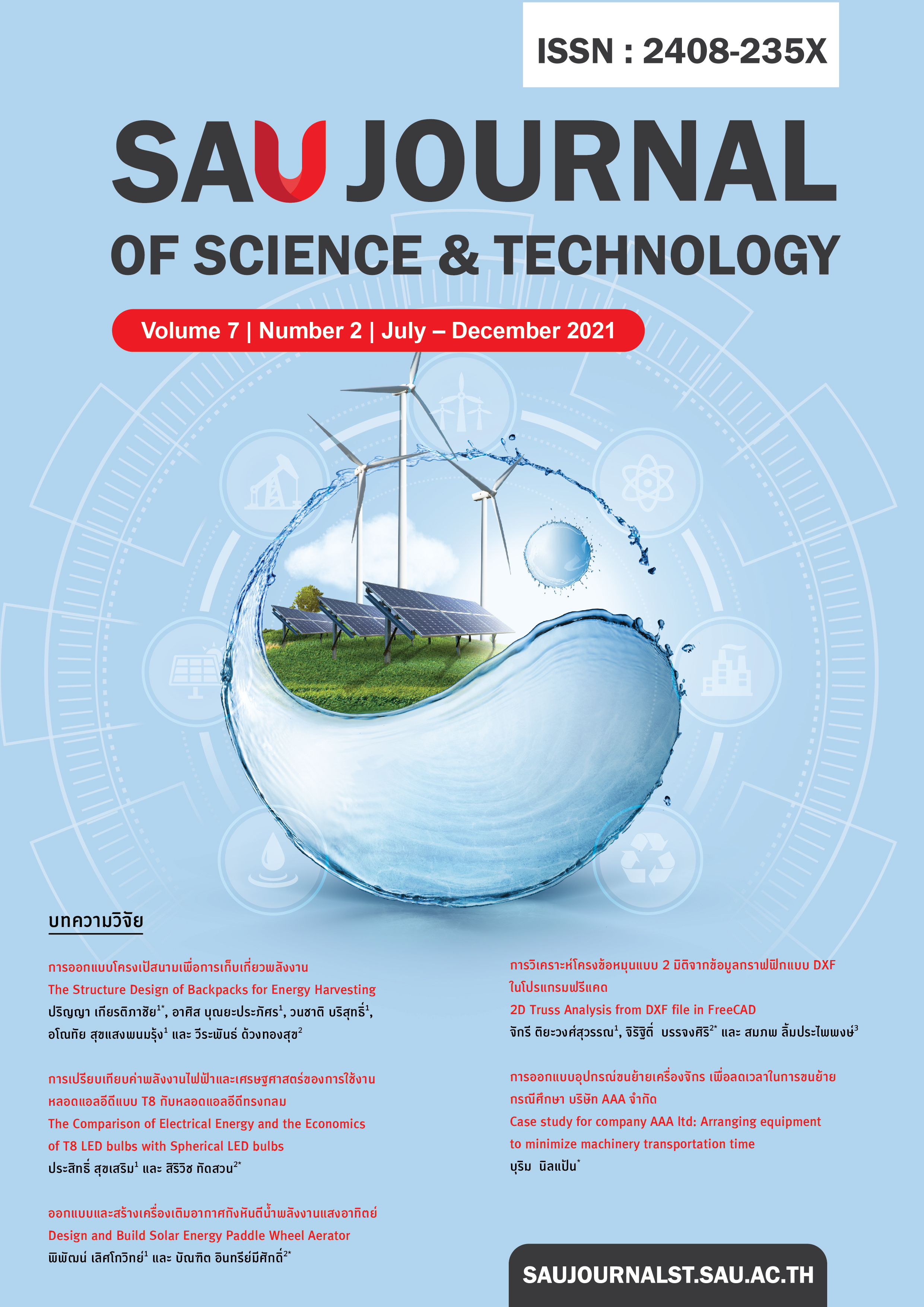Design and Build Solar Energy Paddle Wheel Aerator
Main Article Content
Abstract
This project is to study of solar aerator system by purpose to design a solar power system for aerators using only one solar power source. The project scope had been measuring the water hitting performance of two impeller difference forms which direction can get the direct solar energy. It has been working at 09.00 am - 05.00 pm. by designing the solar pane structure in automation system that is able to move in the sun direction in the morning and in the afternoon by automatic panel system, and this experiment will be conducted at Amata Nakorn Industrial Estate.
By design, it has been implemented with using a common market solar panel on the size of 330 watts which the panes is tilted at an angle of 15 degrees on maximum exposure to the sun comparing to the horizontal and vertical direction and turned the mechanical to the south and used the PLC system to control the entire solar aerator system. The observation was found in the practical application that the weight of structure is submerged too much which will be caused a short circuit breaker to safe the electrical circuit system.
The best result of the solar panel efficiency trials is to place the panel at 15-20 degrees in the south, it was found that the 8-blade propeller can generate oxygen in the water better than the 6-blade propeller which can hit the water as far as 80 centimeters at a motor speed of 2300 rpm, an average current of 1.526 amps. In addition, the 8-blade propeller can hit the water as far as 100 centimeters at 2300 rpm motor with an average current of 1.522 amps. The both propellers use electricity similarly, but the 8-blade propeller can hit the water farther, resulting in better water flow than the 6-blade propeller.
Article Details
References
Pollution Control Department Ministry of Natural Resources and Environment. (2018). [Online] (4 May 2019). (In Thai)
Ministry of Energy. (2014). Solar energy. [Online] Accessed from: (11 May 2019). (In Thai)
https://issuu.com/energy2tomorrow/docs /name1a7 -af4/10 [Online] (12 May 2019). (In Thai)
Nataree Sridaranon, Sopawisitsak and JosephKedari. (2014). Innovative idea of using solar energy. For buildings in the tropics. Journal of the Constructive Environment Faculty of Architecture Khon Kaen University. Year 17 No. 2 July - December 2018 (in Thai)
Ajarn Ampha Sarasiri. (2018). Electric energy from solar cells, clean energy that never goes out. Department of Electrical Engineering. May 28, 2018
Therdsak Saisut and Huaychai Supaphot. (1998). Structural Mechanics. Bangkok: Academic Promotion Center Press.
R. C. Hibbeler, Mechanics of Materials, (2014).
https://www.indiamart.com/proddetail/3hp-paddle-wheel-aerator-19175512391.html [Online] (15 May 2019). (In Thai)
Chartchai Sobun and So Rajaruwanchai (2013). Comparative study on the enhancement of solar cells. Department of Electrical Power Engineering Faculty of Engineering Mahanakorn University of Technology. September 29, 2013
Sirichai Panya Samadhi. (2005). Improving efficiency of solar cells. Master of Science thesis King Mongkut's University of Technology Thonburi.
Krisada Namwong, Phitsanupong Phannarapong and Tangheng Yonsathitkul, Evaluation of the heat transfer performance of solar panels. By using automatic cooling fans, 33rd Meeting of Mechanical Engineering Network of Thailand, 2-5 July 2019, Udon Thani Province.
Chat Phon Nak, Chomphob Waewasak, Sompon Chiwamongkolkarn and Pranee Nuthongkaew, Efficiency Evaluation of Solar PV Rooftop and Connected Distribution Systems of 3 Kilowatts Using PVsyst Simulation. Journal of Thaksin University Year 20, a special issue from the National Academic Conference The 27th Thaksin University 2017 and the 3rd National Conference on Business Administration and Economics.


